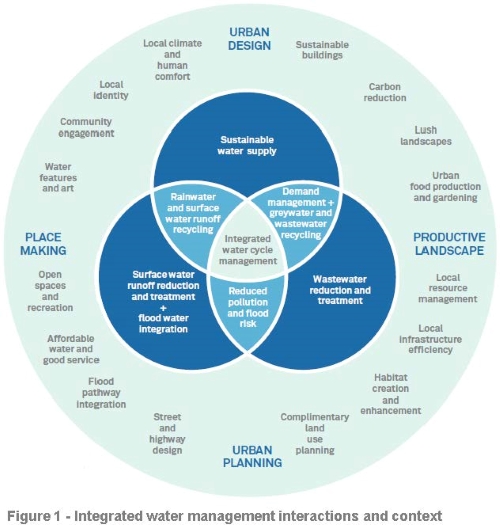Integrated Water Management
Integrated Water Management (IWM) is an approach to planning, design and delivery of places and systems which consider the water cycle as a whole.
Traditionally, water management has been broken into parts, each managed by separate entities. Rather than optimising for a singular outcome, IWM brings together a range of stakeholders to achieve holistic outcomes and to prevent adverse impacts on the water cycle.

Why is Integrated Water Management needed?
In the Macedon Ranges, Integrated Water Management responds to a range of significant regional drivers, including:
- population growth and increased water demand
- increased urban development and the impacts of stormwater runoff on local waterways, in particular the Campaspe River, Jacksons Creek and Five Mile Creek
- projected impacts of climate change on the region
- a need to care for and heal Country.
Council is responsible for the management of most urban stormwater within the shire. This extends to roadside drains across the large number of Council-managed roads between urban township areas.
Water sensitive urban design projects such as passively irrigated street trees, grassed swale minor drainage and stormwater harvesting can reduce urban flow volumes and pollution reaching local waterways.
The Traditional Owner lens brings in additional dimensions for consideration in water management. The Taungurung Country Plan highlights the commitment of Taungurung people to caring for Country, including waterways, land, plants, animals, and cultural sites. For the Dja Dja Wurrung, Gatjin (water) is life, it is a living entity in itself and all life depends on the free flow of water throughout Country.
Council has begun working with members of our First Nations community, including the Taungurung and Dja Dja Wurrung peoples, to incorporate a Traditional Owner perspective for water and to identify any complexities that exist in delivering IWM actions. This approach recognises the importance of Caring for Country and promoting a cross-cultural understanding.
Developing new Integrated Water Management plans
Every IWM plan is different; whether it be driven by major strategic policy implemented at the state or national scale or opportunistically pursued to align with the local context. Each IWM plan must acknowledge its key drivers and respond to its unique local environment to be relevant and effective.
There are a range of factors which make the region unique, including the local context, key drivers and adopted vision for IWM. Council will soon invite the community to have their say on two IWM plans that aim to guide water management projects and policy within the Macedon Ranges.
The Northern Macedon Ranges Integrated Water Management Plan focuses on the development of a new Plan for Kyneton, Woodend, Malmsbury and Tylden, and will review and reaffirm priorities outlined in the Woodend IWM Plan. This Plan will address key priorities such as stormwater, water supply, waterway health, and community amenity.
The Southern Macedon Ranges Integrated Water Management Plan was first developed in 2020. This IWM Plan is aimed at developing a set of objectives and list of key projects for integrated water management in four major townships: Gisborne (including New Gisborne), Riddells Creek, Romsey and Lancefield. The Plan is currently used as a guiding document for water projects owned by both Melbourne Water and Council, and has recently been updated to address revised targets within the Melbourne Water Healthy Waterways Strategy.